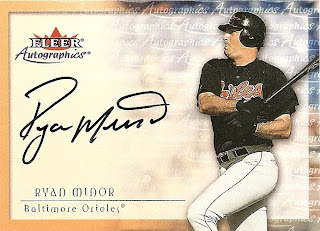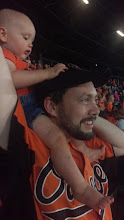
First of all, I've just posted yesterday's entry. I honestly did write the post yesterday evening, but did not post it right away as I was away from my scanner. By the time I got to my PC, I became sidetracked and never remembered to scan and post! It's been a long week, I think.
Anyway, this was also a surprisingly eventful week for Orioles news. I'm going to try to kill a few birds with a single stone today and tackle the news bits that concern O's third basemen past and present. The conversation begins (and usually ends) with
Brooks Robinson, who manned the hot corner for most of the first quarter-century of the team's existence, some 2,870 games. Though #5 still doesn't have a statue on the premises of Oriole Park at Camden Yards (only Charm City native
Babe Ruth holds this honor), he'll soon have one just across the street. On the Russell Street median that sits between the ballpark and Pickles Pub, a 9-foot high bronze statue will depict the 16-time Gold Glove winner winding up to gun down a runner at first base. You can see a model of the statue accompanying
this article. It was the brain child of Baltimore's Public Art Commission and will be sculpted by Maryland native Joseph Sheppard. The piece should be unveiled in time for the 2011 season. I can't wait to see it in its full glory.
Meanwhile, the man who played more games at third base as an Oriole than anyone other than Brooksie has officially been replaced, at least for the short term. With the signing of former Rockies infielder
Garrett Atkins, free agent
Melvin Mora's departure from the club seems much more tangible. While it's still relatively early in the Hot Stove season, I can't help but wonder just how difficult it is for Mora to sit and play the waiting game. There's been next to no buzz about him in the rumor mill; I heard one report linking him to Colorado and one comment left on a MASN blog in which the person claims to have run into Melvin and solicited the player's opinion/belief that he would return to the Mets. I wish him the best no matter where he goes, but based on what I saw with my own lying eyes in 2009, time is running short for him in MLB.
So, what of Garrett Atkins? As word spread this fall that the slugger would not be tendered a contract by the Rockies, I checked out his stats and cringed. Many are treating his dismal 2009 as an off year. Fair enough; he never has been as bad as he was in the just-concluded season. But in truth, his numbers have declined for each of the past three seasons following his breakout in 2006. I won't bother with the counting stats since he lost his starting job last year, but let's just go by OPS+, since it takes on-base plus slugging averages and adjusts them for ballpark and league averages (again, 100 is league-average):
2006: 136
2007: 113
2008: 96
2009: 66
Ugh. If you're curious, MelMo checked in at 79 last year and the equally hard-to-watch
Ty Wigginton was at 87. But I want to be fair, and above all, I want to root for Atkins. So let's weigh the pros and the cons that are being presented elsewhere, along with anything I can cook up on my own.
PROS
-He's hit for power in the past (averaging 25 HR and 110 RBI from 2006-2008), so we know he's capable of it.
-He just turned 30 last week, so we're getting younger at the position and it's not likely that he's washed up so soon.
-He is a righthanded hitter, and boy howdy do we need those.
-He's good buddies with free agent prize
Matt Holliday, so who knows? Maybe he's bait for a bigger fish.
-He won't block top prospect Josh Bell. He's only signed for one year plus a team option for 2011, and if Bell's ready this year Atkins could slide over to first base depending on who is or isn't getting the job done at that position.
-He's (sorta) cheap. You won't find many guys with proven 20-30 HR power for what we'll be paying Garrett ($4-5 million in 2010, depending on incentives).
-There's not much else out there on the market.
Chone Figgins landed a big-years, big-cash deal from the Mariners and
Adrian Beltre (who's no slam dunk himself) will not come easily. Everyone else is jammed together in the pack, so Atkins is as good as anyone.
CONS-He was really bad last year and his performances from 2007-2009 could indicate a troubling trend. Some guys are finished at 30.
-He's got a reputation as a subpar defender. With so much young pitching, one of the best (and still cheapest) ways to improve is by tightening up the 'D'.
-It's hard to ignore those home/road splits. Say what you want about humidors, but he's proven to be a much better hitter in the thin air of Denver than he has elsewhere (120 OPS+ at home, 82 on the road).
-He'll be facing American League East pitching for a huge chunk of the season. Things ain't getting any easier.
-Small sample alert! Garrett has three singles in 23 career at-bats in Baltimore.
-Small sample alert II! In 15 career postseason games, he's hit .231 with one home run. Guy's a choker.
Okay, so a few "cons" were tongue-in-cheek. But I'm still on the fence at best when it comes to our new third sacker. We probably could have done worse, and even I am loath to believe that the dude is as awful as he played in '09. But we all know that the games aren't played on paper, so I'll have to reserve final judgment for next year. May Garrett Atkins prove worthy of Birdland...
 You can't keep a good Bird away from the nest for long.
You can't keep a good Bird away from the nest for long.








































